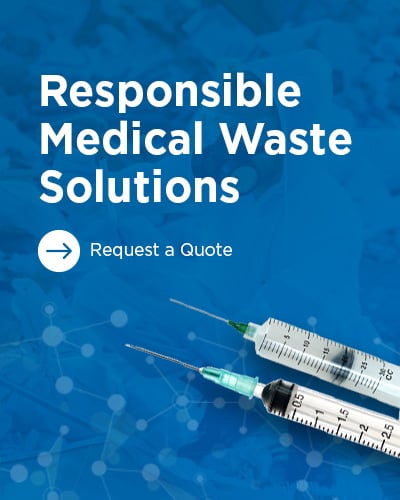Sharps Disposal For Healthcare Facilities
Sharps Disposal
Sharps Disposal can be confusing and intimidating when safely disposing of sharps at home or a healthcare facility. There are many risks associated with handling used sharps and disposing of them properly. Regulations have been put in place to keep the management and care of sharps as unthreatening as possible; however, many sharps are still being thrown out improperly or stored for long periods incorrectly. This creates a hazardous environment for self-injectors, healthcare workers, and the community. This article covers the definition of sharps, how to dispose safely of them, and the different types of medical waste.
or a healthcare facility. There are many risks associated with handling used sharps and disposing of them properly. Regulations have been put in place to keep the management and care of sharps as unthreatening as possible; however, many sharps are still being thrown out improperly or stored for long periods incorrectly. This creates a hazardous environment for self-injectors, healthcare workers, and the community. This article covers the definition of sharps, how to dispose safely of them, and the different types of medical waste.
What are Sharps?
First, let’s talk about what sharps are and where you can find over-the-counter purchases. The FDA describes sharps as a medical term for devices with sharp points or edges that can puncture or cut skin. This includes needles, syringes, auto-injectors, and more. The FDA defines needles as "hollow needles used to inject drugs (medication) under the skin, and medical syringes are devices used to inject medication into or withdraw fluid from the body." People use sharps at home for self-injections, at work, and in healthcare facilities. Sharps are used to manage the medical conditions of people or their pets. A few examples of these conditions are allergies, cancer, and diabetes. You can purchase syringes at your local Walmart supercenter, CVS, or Walgreens or you can order through PureWay's sharps container disposal system online. Over-the-counter sharps vary based on pharmacist regulations. Different sizes of syringes, distribution amount, and age requirements may vary. Typically, over-the-counter syringes can only be distributed to people aged 18 and older while certain restrictions apply. Some pharmacies don’t require a prescription in order to sell you syringes.
Download PureWays Sharps Free
Sharps Disposal Protocol Poster
How do I dispose of Sharps?
Now that you know what sharps are, I will tell you how to properly dispose of them at home and in a healthcare facility. Once a sharp is used for its intended purpose, it is essential to dispose of it immediately. This reduces further contact, and workers can avoid accidental pricks and potential exposure to a hazardous substance. When someone is unintentionally cut or punctured by a sharp, this is called needlesticks.
OSHA estimates that when accounting for both hospitals and other health care settings, between 600,000 and 800,000 needlestick injuries occur annually to health care workers.
Avoiding needlesticks is a major priority for healthcare facilities. You should place sharps in an FDA-approved sharps container immediately after their use. Sharps containers are puncture resistant, leak-proof, and specially designed to hold sharps inside for storage, transport, and disposal. These containers must be confined to regulations such as specific color coding, proper labeling, hazardous substance markings, and safe closure. Documenting this process is important because it helps keep sharps on track to safe disposal.
 1.2 Gallon PureWay FDA Approved Sharps Container
1.2 Gallon PureWay FDA Approved Sharps Container
Sharps containers should be prepared for disposal once they reach three-fourths (75%) full or when the contents reach the dedicated line. If you do not have access to a designated sharps container, there are at-home bins that can be used to substitute in the meantime if you are a home user. These substitutes include heavy-duty laundry detergent containers with puncture-resistant material and a closeable lid.
Sharps and sharps containers should be kept out of reach from children and pets. Medical waste disposal companies such as PureWay take care of sharps containers and disposal for your convenience. You can also go to collection sites or certain healthcare facilities that will take your sharps containers and dispose of them for you, or you can order a prepaid return shipping label from PureWay's website. Once your container is full, the system can be provided to a mail carrier, or a pick-up can be scheduled on request. Patients can take part in this collection and disposal system for their needles, syringes, or other injection devices when they pick up their prescriptions at any Walgreens location. For more information, visit the Walgreens website or check in person for your options.
How do I dispose of medical waste?
Disposal of sharps is provided by many healthcare facilities, but how do they dispose of other medical waste? The EPA defines medical waste as healthcare waste that may be contaminated by blood, body fluids, or other potentially infectious materials and is often referred to as regulated medical waste.
Medical waste includes human blood and blood products, human body fluids, microbiological waste, pathological waste, animal waste, and sharps waste. The EPA emphasizes alternative treatments are generally used to render the medical waste non-infectious before the waste can be disposed of as solid waste in landfills or incinerators. To be certified, licensed, or regulated, different states have varying regulations regarding medical waste treatment technologies.
What is regulated medical waste?
Now that you know medical waste is also referred to as regulated medical waste, I’ll go about the specifics. Regulated medical waste means any liquid or semi-liquid blood, potentially infectious materials, and contaminated items that would release blood or other potentially infectious materials in a liquid or semi-liquid state if compressed, as defined by OSHA. This includes items filled with dried blood or other infectious materials capable of releasing these materials during handling. While you may be familiar with sharps waste, what happens with amputated body parts once they are removed in hospitals might come to mind. When limbs are amputated, a patient signs a waiver giving up ownership of their limb to a pathological lab. Patients often have the option to donate it to science, but if not, hospitals will dispose of the limb(s) as medical waste. Once disposed of, body parts are incinerated in order to reduce the risks of contamination. The EPA states that “Medical waste incineration involves the burning of wastes produced by hospitals, veterinary facilities, and medical research facilities. These wastes include both infectious medical wastes as well as non-infectious, general housekeeping wastes.”
Why is Sharps Disposal important?
In order to keep healthcare workers and home injectors safe, it is important to properly dispose of sharps and other medical waste. Per the U.S. Food and Drug Administration, 9 million people use needles, syringes, or other “sharps” at home. If that much sharps waste were thrown out in the trash per year, there would be serious environmental and health conflicts. To keep sharps from being a hazard, you should safely dispose of them according to regulations. PureWay offers sharps containers and disposal processes for your convenience, so check out which plan works best for you.
Article Sources:
- Center for Drug Evaluation and Research. “Safely Using Sharps (Needles and Syringes) at Home, at Work, and on Travel.” U.S. Food and Drug Administration, 19 Nov. 2021, www.fda.gov/medical-devices/consumer-products/safely-using-sharps-needles-and-syringes-home-work-and-travel.
- “1910.1030 - Bloodborne Pathogens. | Occupational Safety and Health Administration.” Occupational Safety and Health Administration, www.osha.gov/laws-regs/regulations/standardnumber /1910/1910.1030. Accessed 2 July 2022.
- https:\/\/www.aftermath.com\/blog\/author\/keith-vera\/#author. “Learn More about OSHA’s Biohazardous Waste Regulations and Standards | Aftermath Services.” Aftermath Services | Crime Scene Clean Up & Death Cleanup Professionals, 31 Aug. 2017, www.aftermath.com/content/osha-biohazardous-waste.
- “Medical Waste.” US EPA, 14 May 2022, www.epa.gov/rcra/medical-waste.
- “Part I: Background - Sharps Safety | CDC.” Sharps Injury Prevention, www.cdc.gov/sharpssafety/part1TEXTONLY.html. Accessed 14 July 2022.
- Sean. “How Do Generators Dispose of Amputated Body Parts?” Red Bags, 14 Oct. 2018, www.redbags.com/dispose-amputated-body-parts-disposal.
- “U.S. Environmental Protection Agency.” US EPA, www.epa.gov. Accessed 2 July 2022.






